2 things we always need to know about every sales opportunity
February 1, 2023
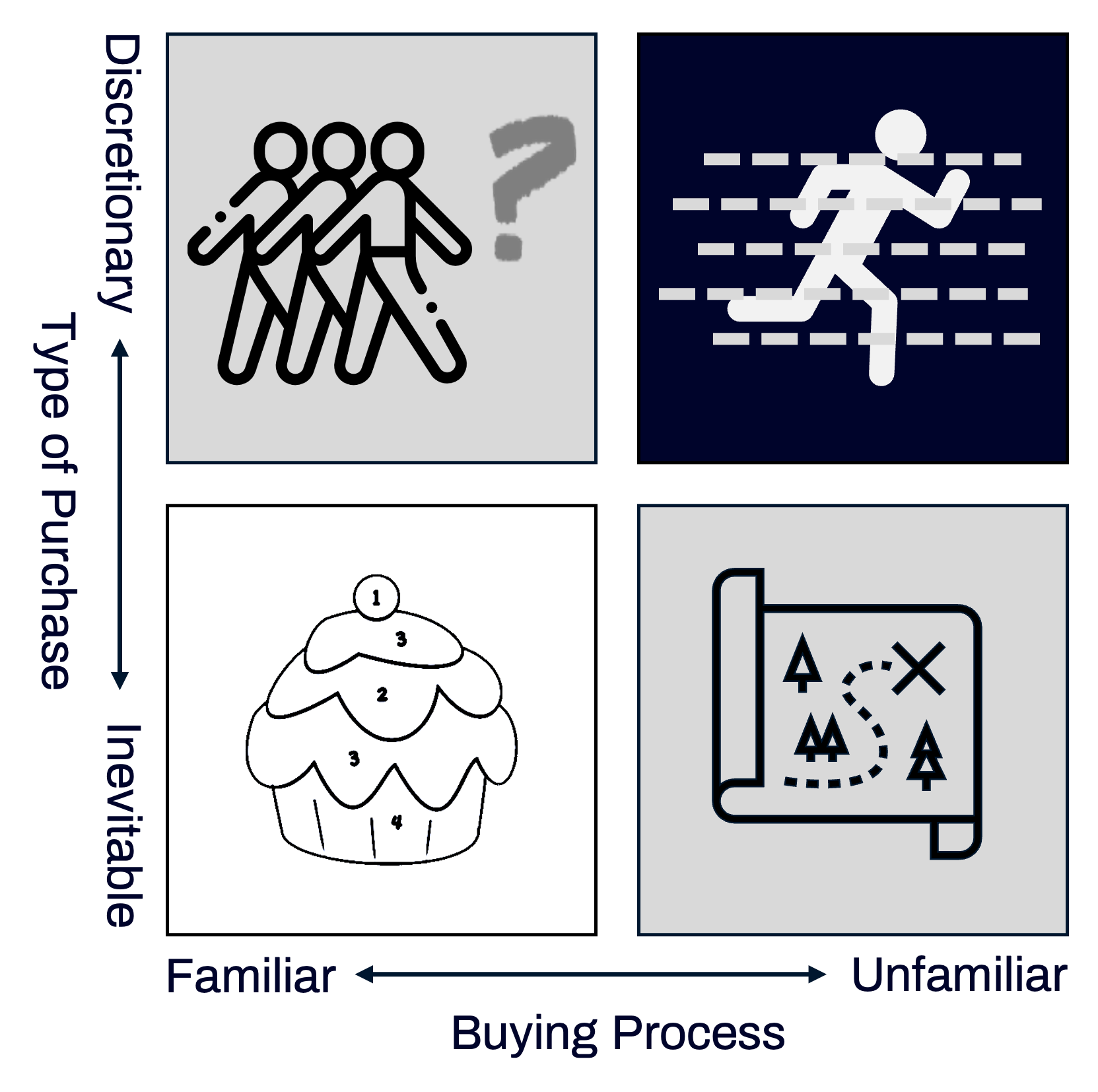
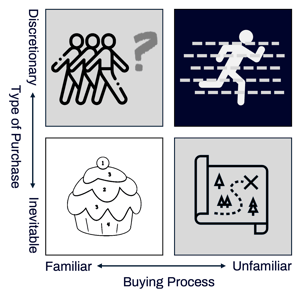 Every competent salesperson recognizes the importance of accurately qualifying every sales opportunity.
Every competent salesperson recognizes the importance of accurately qualifying every sales opportunity.
But I want to suggest two other things that we also always need to know about every sales opportunity - and they relate to the nature of our prospective customer’s buying journey.
These two factors are:
- Do they consider this to be an inevitable or a discretionary purchase, and
- Are they embarked on a familiar or unfamiliar buying process?
These two factors have very significant implications for our customer’s buying decision journey, for our sales strategy and process, and for our chances of winning their business - and I’m going to spend the rest of this article exploring the ramifications of these factors.
This post is longer than usual and was originally published on LinkedIn. I’ll also be covering the material in my webinar with the Institute of Sales Professionals on the 7th February - you can sign up here...
Factor #1: Is this an inevitable or a discretionary purchase?
- If this is an inevitable purchase (such as materials or supplies for an ongoing process), the customer must buy something - the key questions being what, from whom, and on what terms?
- If this this a discretionary purchase (such as something that isn’t budgeted and may never happen), then the customer might buy something - or they might decide to stick with the status quo and do nothing
Factor #2: Are they embarked on a familiar or unfamiliar buying process?
- If the customer has bought similar solutions before, they are likely to be confident about their buying decision criteria and process (and may not wish to engage a salesperson until late in the process)
- If this is the first time the customer has tried to buy this type of solution, they are more likely to recognize that they need to seek advice in the early stages of their buying decision journey
Taken together, these factors define a classic 2x2 matrix.
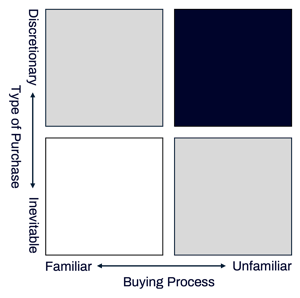
Let’s look at each of these combinations in turn, starting with the simplest:
Scenario 1: “Painting by Numbers” [Inevitable Purchase + Familiar Process]
In this first scenario - which I refer to as “painting by numbers”, the customer is bound to buy something and is following a well-established and familiar structured procurement process - they simply need to decide what to buy, from who, at what price and when.
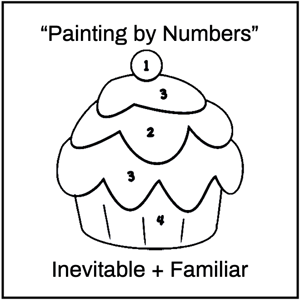
Typical “painting by numbers” scenarios include:
- Buying energy (such as gas or electricity)
- Buying raw material for an established production process
- Replenishing stocks for retail or distribution
- These buying journeys are often driven by a simple compelling event (such as running out of something)
A simple consumer example of this sort of scenario would be a driver noticing that their petrol is running low and looking out for a filling station.
Common indicators and implications of a “painting by numbers” scenario include
- Highly structured procurement process, occasionally involving a simple RFP
- Regarded as a tactical purchase that doesn’t involve strategic considerations
- Often managed by relatively low-level employees
- Incumbent suppliers often have significant advantages (unless customer is dissatisfied)
- The decision is often driven by specification, price, and delivery
Sales Strategies - Painting by Numbers
If we want to avoid competing on price, and in particular if we are trying to dislodge an incumbent, we need to find meaningful ways to differentiate both our organization and our offerings and establish urgency - i.e., focusing on “why us” and “why now”
What we need to know and do:
- Confirm that it is, in fact, absolutely inevitable that the customer will buy something in the current timeframe (and why) - seek out the evidence
- Confirm that the primary sponsor of the project is, in fact, an experienced buyer and fully familiar with their organization’s procurement processes
Assuming that evidence exists to prove both of the above facts, our strategy should include:
- Focusing primarily on establishing “why should they choose us”
- Seeking to influence the customer’s requirements and buying criteria in our favor
- Ensuring we identify and engage all stakeholders and understand their decision process
- Seeking to prove that our offering will deliver their best outcomes
- Differentiating on our approach and track record and not just on features and functions
- Reinforcing the need to act sooner, rather than later (“why now”)
- Ensuring we establish our unique value and defend our price points...
Scenario 2: “Marching into the Unknown” [Discretionary Purchase + Familiar Buying Process]
In this second scenario - which I call “marching into the unknown” - the customer may or may not end up buying something - but they nevertheless appear to be following what they regard as a well-established and familiar structured procurement process.
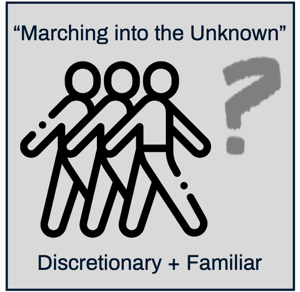
Typical “marching into the unknown” scenarios include:
- A potential - rather than inevitable - project or purchase
- The customer may yet not be convinced about the need for change
- The customer is not initially committed to take action
- There is no obvious compelling event
A simple consumer example of this might be “retail therapy” - going out on a shopping trip without actually needing to buy anything.
Common indicators and implications of a “marching into the unknown” scenario include:
- Even though action is not inevitable, the customer is nevertheless following a well-established procurement process, sometimes involving an RFI or RFP
- They are likely to involve a significant number of stakeholders
- Their timeframe may be unclear, and lack urgency
- “Strategic” decision-makers are more likely to get involved
- The customer’s decision-making process appears to be structured but may not be appropriate to the task
Sales Strategies - Marching into the Unknown
Our emphasis needs to be on why the customer needs to change and why they need to act now as well as why the customer should buy from us.
What we need to know and do:
- Assess our prospective customer’s commitment to change and do all that we can to motivate them to take action - i.e., “why change” - and be cautious when forecasting if the customer’s need for change does not appear strong
- Establish the strongest possible reasons for our prospective customer to act sooner rather than later - i.e., “why now” - and be cautious when forecasting if the customer’s urgency does not appear strong
Plus, as for inevitable + familiar projects - establish the strongest possible case for “why you”
- Seek to influence the customer’s requirements and buying criteria in our favor, and
- Ensure we identify and engage all stakeholders and understand their decision process
- Seek to prove that our offering represents their best solution
- Differentiate on our approach and track record and not just on features and functions
- Ensure we establish our unique value and defend premium pricing
Scenario 3: “Orienteering” [Inevitable Purchase + Unfamiliar Buying Process]
The third scenario - which I call “orienteering”, the customer is bound to buy something - but because the decision process is unfamiliar, they may need help in determining how to buy, who to buy from, and when to act.
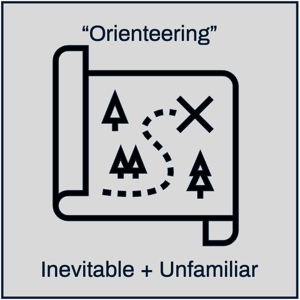
Typical “orienteering” scenarios include:
- They are often regarded as significant or strategic projects that take the customer in a new direction
- The customer recognizes that they must do something
- The customer is stepping into the unknown - trying to do something they haven’t done before
- There is often a compelling event, trend, or threat
A simple consumer example of this might be an about-to-be-married couple looking for a wedding venue.
Common indicators and implications of an “orienteering” scenario include:
- The customer is trying to buy something they haven’t bought before
- The customer recognizes that they are embarked on an unfamiliar buying process
- They recognize that the risk of failure/making a bad decision is significant
- They may be more willing to take advice and engage with salespeople earlier than usual
- The project is likely to involve a significant number of stakeholders
- “Strategic” decision-makers are more likely to get involved
Sales Strategies - Orienteering
As well as answering why us, we need to address why now and work with the customer to become a trusted adviser - and to influence their requirements, buying criteria and decision process.
What we need to know and do:
- Confirm that it is, in fact, absolutely inevitable that the customer will buy something in the current timeframe (and why) - seek out the evidence
- Establish the strongest possible case for “why you”
- Seek to influence the customer’s requirements in our favor
- Ensure we identify and engage all stakeholders and understand their decision process
- Seek to prove that our offering represents their best/safest solution
- Differentiate on our approach and track record and not just on features and functions
- Seek to establish our unique value and defend premium pricing
- Establish the strongest possible reasons for our prospective customer to act now rather than later (“why now”)
- Seek to understand and influence our prospective customer’s buying criteria and decision process - why should they trust you?...
Scenario 4: Running in the Fog [Discretionary Purchase + Unfamiliar Buying Process]
Finally, the most challenging - but far from uncommon - scenario, which I refer to as “running in the fog” (a phrase originally introduced to me by Professor Eddie Obeng of Pentacle, the World’s first Virtual Business School): The customer isn’t completely sure whether they need to buy or how to decide - everything in their buying decision journey is open to influence.
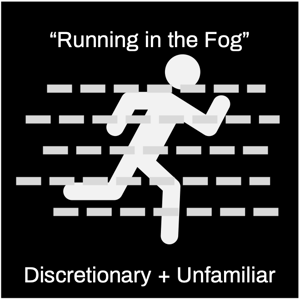
Typical “running in the fog” scenarios include:
- The customer feels that they might need to do something but aren’t sure what or when
- The customer isn’t sure how to go about evaluating their options
- The customer is searching for information about the issue
- They often are as focused on the nature of the problem as the appropriate solution
These sorts of scenarios are often driven by a sense of restlessness with the current situation without any sense of what a better future might look like or how to get there. Some observers might conclude that the whole Brexit debacle is a good example.
Typical indicators and implications of a “running in the fog” scenario include:
- The customer thinks they might need to do something they haven’t tried to do before
- The project is not currently budgeted
- The project may be initially driven by a subset of the eventual stakeholder group
- The customer recognizes that they are embarked on an unfamiliar buying process
- They recognize that they need advice
- They may be more willing to engage with salespeople earlier than usual
Sales Strategies - Running in the Fog
Our customer is asking themselves: why change, why you, why now and why trust? As well as why change, we need to address why us and now and work with the customer to establish and influence their buying criteria and decision process and win their trust
What we need to know and do:
- Make the strongest possible case for change and to highlight the negative outcomes of continuing on their current path (“why change”)
- Positively differentiate our approach from all their other options in ways that are memorable and meaningful to the customer (“why you”)
- Establish the strongest possible reasons for our prospective customer to act now rather than later (“why now”)
- Become a trusted adviser and influence our prospective customer’s buying criteria and decision process as early as possible in the buying journey (“why trust”)
- Progressively identify and eliminate any remaining obstacles to winning their business
- Ensure that they completely trust us to ensure that they will achieve their desired outcomes...
Different scenarios require different strategies
I hope that I’ve convinced of the value of understanding the nature of your prospective customer’s purchasing intentions and their buying decision process, and of the need to apply different sales strategies to the different scenarios.
I also hope that you recognize that “one size does not fit all” when it comes to your management of your sales opportunities, and that the sort of thought processes that I’m proposing will help you eliminate many of the avoidable errors and assumptions that so often compromise our chances of winning the sale.
An accurate identification of each prospective customer’s scenario will also help you more realistically qualify the opportunity and avoid wasting effort on unwinnable deals. Here’s the link to that webinar again.
Please try putting these principles into practice - and be sure to let me know how you get along!
About the Author
 Bob Apollo is a Fellow of the Institute of Sales Professionals, a founding contributor to the International Journal of Sales Transformation, a recognised Sales Futurist, and the driving force behind Inflexion-Point Strategy Partners, the leading proponents of outcome-centric selling.
Bob Apollo is a Fellow of the Institute of Sales Professionals, a founding contributor to the International Journal of Sales Transformation, a recognised Sales Futurist, and the driving force behind Inflexion-Point Strategy Partners, the leading proponents of outcome-centric selling.
Following a successful corporate career spanning start-ups, scale-ups and market leaders, Bob now works as a strategic advisor, mentor, trainer and coach to ambitious B2B sales organisations - teaching them how to differentiate themselves through their provably superior approach to achieving their customer's desired outcomes.


Comments